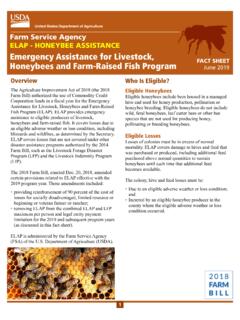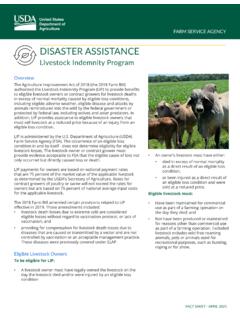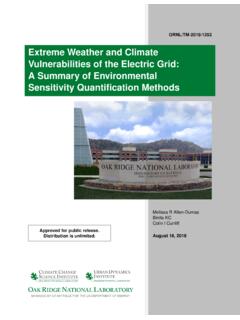Transcription of How to Obtain a Good Weather Briefing - FAASafety.gov
1 How to Obtain a Good Weather Briefing IntroductionHere are some tips on how to get a good Weather Briefing . This document complements other pilot educational material published by the Federal Aviation Administration (FAA) and other aviation like everything else in life, practice makes perfect, or nearly so. If you practice getting a Weather Briefing on a regular basis, then after just a few sessions you will be like an old pro and will know how to get a quality Weather : The use of the generic terms Flight Service and Flight Service Station (FSS) in this document should be understood to include both Automated Flight Service Stations and nonconsolidated Flight Service Stations. Flight Service should not be confused with Flight Watch, which is the call sign for En Route Flight Advisory Service (EFAS).Anatomy of a Good Weather BriefingA good Weather Briefing begins with developing a total awareness of the overall big picture before obtaining a detailed or standard Briefing .
2 Many pilots start by monitoring Weather patterns through commercial television, such as The Weather Channel, several days before the flight. The day or evening before the flight, pilots may wish to Obtain an outlook Briefing from Flight Service or electronically from a Direct User Access Terminal (DUAT) vendor, or they may choose to download Weather and forecast charts from the Internet. (When using DUATs, don t hesitate to contact Flight Service to clarify any information you do not fully understand.) As close to departure time as possible, call Flight Service or log on to DUAT for a standard Briefing . (Of course, you can also access high-quality Weather products on the Internet or via other sources, but first make sure that the menu of products is suitable for aviation use and the products are current.) If you Obtain a standard Briefing several hours before the flight or when the Weather is questionable, it is a good practice to call an FSS for an abbreviated Briefing just before FAA has established a universal toll-free telephone number for FSSs: 1 800 WX BRIEF (1 800 992 7433).
3 Before contacting Flight Service, you should have the general route of flight worked out. When you reach Flight Service, you will first hear a recorded announcement, followed by instructions. The system will provide a voice selection to the following options: Briefer or Telephone Information Briefing Service (TIBS) or for Special Announcements. If you say Briefer or TIBS, you will be prompted to speak the State you are calling from and, in some cases, a more specific area. (Example: if you say Florida, you will then asked if you want Northern Florida or Southern Florida. If you then say Northern Florida, you will hear please wait while I connect you to a briefer. )To help the briefer provide you with the best service, state your request (that is, a standard, abbreviated, or out-look Briefing or to file a flight plan). Provide the briefer with the following background information so that your Briefing can be tailored to your needs: Your qualifications (for example, if you are a student, private, or commercial pilot and if you are instrument rated).
4 Type of flight planned visual flight rules (VFR) or instrument flight rules (IFR). Aircraft N-number or pilot's name. Aircraft type. Departure point. Estimated time of to Obtain a Good Weather Briefing Proposed flight altitude(s). Proposed route of flight, if other than direct; specify any landing points along the way. Destination. Estimated time en you ask the briefer to provide a standard Briefing , the Briefing will follow specific procedures and use standard phraseology developed by Flight Service personnel. The briefer will first advise you of any adverse conditions along your proposed route of flight. When a VFR flight is proposed and actual or forecast conditions make a VFR flight questionable, the briefer will describe the conditions and may advise you that "VFR flight (is) not recom-mended." You are still entitled to a complete Briefing ; however, if you think the Weather conditions are beyond your capabilities (or that of your aircraft or equipment), you should consider terminating the Briefing (and your flight), enabling the briefer to handle other incoming of the "VFR not recommended" statement does not necessarily guarantee a flight free from adverse Weather effects.
5 Phenomena such as thunderstorms, turbulence, mountain obscurations, and strong winds do not, in and of themselves, warrant this statement. Only you, the pilot in command, know your own capabilities and typically summarize Weather reports and forecasts unless you specifically request that these items be read verbatim. Try not to interrupt the briefer unless he or she is speaking too fast. At the conclusion of the brief-ing, ask for any additional information you may require or for clarification of any point you do not completely understand. The amount of detail in your Weather Briefing will depend on the complexity of the Weather situation. It is both your responsibility and prerogative as a pilot to Obtain a standard of Weather BriefingsStandard BriefingThe standard preflight Briefing includes the following elements: adverse Conditions. Significant meteorological information (SIGMET) (for example, thunderstorms, icing, turbulence, low ceilings or visibility) that might influence you, the pilot, to alter your proposed route of flight or even cancel your planned flight entirely.
6 Synopsis. A brief statement about the cause of the Weather (for example, fronts or pressure systems) that is pertinent to your proposed route of flight. Current Conditions. When your proposed time of departure is within 2 hours, current conditions include a summary of the current Weather , including Pilot ( Weather ) Reports (PIREPs) and radar Weather information applicable to your planned flight. En Route Forecast. The briefer will summarize the forecast conditions (unless requested to read the forecasts verbatim) along your proposed route in a logical order (that is, climbout, en route, and descent). Destination Forecast. The briefer will provide the destination forecast for your estimated time of arrival, including any significant changes expected within 1 hour of your planned time of arrival. Winds Aloft. The briefer will summarize Forecast Winds Aloft (FD) for the proposed route.
7 Temperature information will be provided on request. How to Obtain a Good Weather Briefing Notices to Airmen (NOTAMs). The briefer will provide current NOTAMs pertinent to your proposed route of flight in a standard Briefing . Information on Global Positioning Systems outages, Long Range Navigation Military Training Routes (MTRs) and Military Operations Areas (MOAs) and published NOTAMs must be specifically requesting the status of MTRs and MOAs, please provide the briefer with the MTR route number identifier or MOA name. It is always good practice to inquire whether the briefer has access to all military activity along your proposed route or whether you will also need to contact another FSS (on standard FSS radio frequencies) along your route of flight to check on the activity and status of designated military Weather BriefingRequest an abbreviated Briefing when you need information to supplement other electronically acquired data (for example, TIBS or DUAT) or update a previous Briefing or when you need only one or two specific items.
8 Provide the briefer with appropriate background information, the time you received the previous information, and the specific items needed. You should indicate the source of the information already received so that the briefer can limit the Briefing to the information that you have not received and provide significant changes in meteorologi-cal conditions or aeronautical information since your previous Briefing . To the extent possible, the briefer will provide the information in the sequence used in a standard you request only one or two specific items, the briefer is required to advise you if adverse conditions are pres-ent or forecast. Details on these conditions will be provided at your request. Often, and especially when doing local flying, you may want to receive an update of the Weather at a specific airport. To do so, you may directly dial an automated Weather system, if available, at that airport.
9 Note: A more detailed description of Automated Observation Systems (AWOSs) is in the Aeronautical Information BriefingRequest an outlook Briefing whenever your proposed time of departure is 6 or more hours in the future. In this case, the briefer will provide you with available forecast data applicable to your proposed departure time. This type of Briefing is provided for planning purposes only. You should Obtain a standard Briefing as close to depar-ture time as possible to Obtain the latest current conditions, forecasts, and NOTAMs. Often, graphical Weather depictions obtained through DUAT or the Internet can provide excellent trend information and may be used BriefingIf at all possible, Obtain a preflight Briefing by telephone or by electronic means before departure. If you are already in flight and need to Obtain a standard Briefing or update a previous Briefing in flight, contact Flight Service, not Flight Watch.
10 After contact, advise the specialist of the type of Briefing you require and provide appropriate background information, the specialist will then provide information as specified in the preceding paragraphs, depending on the type of Briefing you (Flight Watch) is not meant to provide you with a full standard Briefing . Rather, rely on EFAS to provide you with the most current en route Weather . When using EFAS, always give a PIREP so other pilots may benefit from your reports of the Weather , ride, and so to Obtain a Good Weather Briefing In-Flight Datalink WeatherTechnology advancements now enable suitably equipped aircraft to receive textual and graphical datalinked Weather products and other information, Just like using Weather information received over the Internet, however, the pilot, especially when in flight, must use the most current information, not out-of-date or invalid Weather products.















